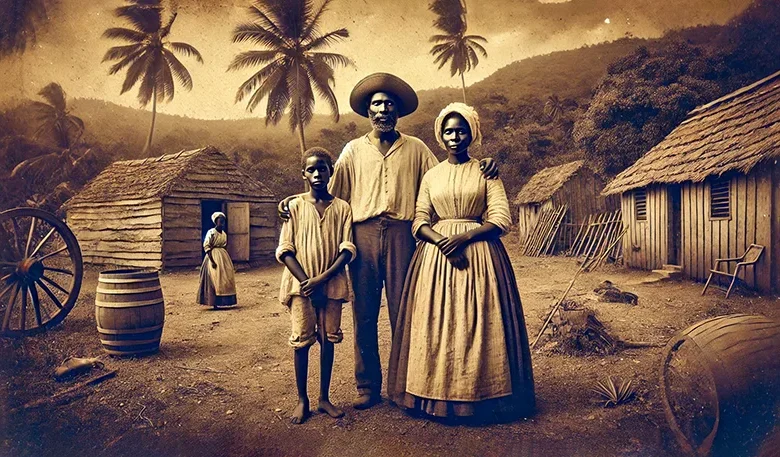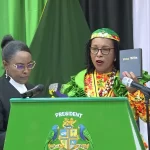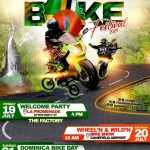Slavery in Dominica

Slavery in Dominica was central to the island’s history from the 16th to the 19th century, shaping its social, economic, and cultural heritage. The transatlantic slave trade brought thousands of enslaved Africans to Dominica, where they laboured under brutal conditions on plantations. The legacy of slavery continues to influence the island’s society and heritage today.
Slavery and Dominica’s History
The history of slavery on the island is interwoven with European colonization and the rivalry between France and Britain for control over Caribbean territories.
The indigenous people, the Kalinago, originally inhabited Dominica. European contact began when Christopher Columbus sighted the island on his second voyage in 1493, naming it “Dominica” for the day of the week (Sunday) on which he encountered it. Due to fierce resistance from the Kalinago, significant European settlement occurred in the 17th century.
French Settlement and the Rise of Plantations
In the early 1690s, French settlers from Martinique and Guadeloupe began establishing small settlements. They introduced enslaved Africans to cultivate coffee, cocoa, and cotton plantations. The French implemented the Code Noir in 1685, a set of laws regulating the treatment of enslaved people and outlining the rights of slave owners.
Under French rule, the economy began to develop around plantation agriculture, relying heavily on the labor of enslaved Africans. The fertile volcanic soil and favourable climate made Dominica ideal for growing cash crops.
British Control and Expansion of Slavery
The Treaty of Paris in 1763 ceded Dominica to the British after the Seven Years’ War. The British expanded the plantation system, focusing on sugarcane, which was highly profitable due to the European demand for sugar. The number of plantations increased, particularly in areas like Portsmouth, the Roseau Valley, and the fertile plains of the northeast.
By the 1770s, the enslaved population had grown significantly. Records from 1773 indicate there were approximately 15,000 enslaved Africans on the island, compared to a few hundred European settlers. The British implemented strict slave codes to control the large enslaved population and maximize economic output.
The Nature of Slavery in Dominica
Enslaved Africans worked primarily on sugar, coffee, cocoa, and cotton plantations. Notable estates from that period include:
- Geneva Estate: Located near Grand Bay in the south of Dominica, Geneva Estate was known for its sugar production and played a significant role in the island’s colonial economy.
- Canefield Estate: Situated on the west coast, north of Roseau, Canefield Estate was a major sugar plantation. It was owned by various individuals, including Walter Pringle and later George Henry Rose.
- Macoucherie Estate: Located in the parish of St. Joseph, Macoucherie Estate was involved in sugar production. In 1804, it was owned by James Laing and Robert Reid.
- Hillsborough Estate: This estate was notable during the slavery period, with records indicating instances of slave resistance and punishment.
- Polus Estate: Also significant during the slavery era, Polus Estate is mentioned in historical records concerning slave activities and disciplinary actions.
These estates were integral to Dominica’s economy during the colonial period, relying heavily on the labour of enslaved Africans. The legacy of these plantations is still evident today, with some areas retaining their original estate names and others transitioning into modern agricultural or tourism ventures.
The work was gruelling and conducted under harsh conditions. Enslaved people endured long hours, inadequate nutrition, and brutal punishments for infractions.
Families were often separated, and cultural practices were suppressed as part of the strategy to control the enslaved population. However, enslaved Africans resisted by preserving elements of their cultural heritage through music, dance, and religious practices.
The Role of Maroons in Dominica
Maroons were enslaved Africans who escaped from plantations and formed independent settlements in remote, mountainous regions. In Dominica, the dense rainforests and rugged landscape of Morne Diablotin and Morne Trois Pitons provided refuge for Maroon communities.
These communities maintained African traditions and posed significant challenges to colonial authorities. They conducted raids on plantations, freeing other enslaved people and disrupting the plantation economy.
Notable Maroon Leaders
One of the most renowned Neg Mawon Chiefs was Cheif Jacko (also spelled Jaco or Jaco Macacco), who led resistance efforts in the late 18th century. Jacko established a stronghold known as Jacko Flats near Morne Diablotin. From there, he orchestrated attacks on plantations, undermining British control.
Another significant figure was Pharcelle, who, along with his followers, resisted colonial forces and inspired others to join the Maroon communities.
Slavery Revolts and Uprisings in Dominica
The enslaved population engaged in various forms of resistance, ranging from subtle acts of defiance to organized revolts.
The Haitian Revolution, which began in 1791, had a profound impact on enslaved populations throughout the Caribbean. In Dominica, news of the uprising in Saint-Domingue (now Haiti) inspired hope and agitation among the enslaved.
In 1791, a significant revolt occurred on the island. Enslaved people on several plantations rose up against their masters, resulting in violent confrontations. Although the revolt was eventually suppressed, it heightened fears among colonial authorities and led to harsher measures to prevent future insurrections.
Before the 1791 revolt, the Negro Conspiracy of 1785 was a planned uprising discovered before it could be carried out. The conspiracy involved a network of enslaved individuals intending to overthrow the plantation system. Its discovery led to severe punishments and increased surveillance of the enslaved population.
Slavery and the Abolition Movement in Dominica
In the late 18th and early 19th centuries, Britain’s abolition movement gained momentum, driven by humanitarian concerns and economic factors.
The Slave Trade Act of 1807
In 1807, the British Parliament passed the Slave Trade Act, abolishing the transatlantic slave trade in the British Empire. This law prohibited the transportation of enslaved Africans to British colonies but did not end slavery itself.
The Slavery Abolition Act of 1833
The Slavery Abolition Act was passed in 1833, leading to the gradual emancipation of enslaved people in British colonies. This process began on August 1, 1834, on the island, with the implementation of the Apprenticeship System. Under this system, formerly enslaved people were required to continue working for their former masters for four to six years, ostensibly to transition to freedom. In practice, it was a continuation of forced labor with minimal improvements in conditions. On August 1, 1838, the Apprenticeship System was abolished, and all formerly enslaved individuals were granted full emancipation.
Slavery’s Impact on Dominica Society and Economy
After emancipation, many freed people left the plantations and established their own communities. Villages such as Grand Bay, Marigot, and Wesley became centers of Afro-Caribbean culture and self-sufficiency. Freedmen engaged in subsistence and small-scale agriculture, growing crops like yams, bananas, and other staples.
Land Ownership and Economic Challenges
Access to land was a significant issue post-emancipation. While some freed people managed to acquire small plots, much fertile land remained under the control of former plantation owners. This inequality led to economic challenges and limited opportunities for most of the population.
The plantation economy declined due to labor shortages and reduced profitability. Planters struggled to adapt, and some estates were abandoned or sold.
Arrival of Indentured Laborers
To address labor shortages, the British introduced indentured laborers from India between 1854 and 1864. These workers signed contracts to work on plantations for a fixed term in exchange for wages and eventual return passage or settlement. The arrival of East Indians added to the cultural diversity of the island.
Cultural and Social Impact of Slavery
Despite efforts to suppress African culture during slavery, many traditions survived and evolved. Afro-Caribbean music and dance forms, such as Bélé and Quadrille, reflect the fusion of African rhythms and European influences. Drumming, singing, and dancing became integral to community celebrations and rituals.
The Creole language (Kwéyòl) developed as a blend of French, African languages, and English, serving as a means of communication among the diverse population.
Religious practices incorporated African spiritual beliefs with Christianity, leading to syncretic religions and customs.
Cultural Festivals and Celebrations
The island’s Carnival, known locally as Mas Domnik, has roots in both African and French traditions. Celebrated annually before Lent, it features calypso music, costume parades, and traditional dances.
Emancipation Day, observed on the first Monday in August, commemorates the abolition of slavery and includes cultural events, educational programs, and reflections on history.
Present-Day Landmarks and Heritage Sites
The island preserves several sites that offer insights into its history of slavery.
- Located near Portsmouth in Cabrits National Park, Fort Shirley is a restored 18th-century British garrison. Built using the labor of enslaved Africans, the fort played a role in the island’s defense. Today, it serves as a historical site and venue for cultural events.
- Overlooking the capital city of Roseau, Morne Bruce was a strategic military site during colonial times. Visitors can explore the remnants of fortifications and enjoy panoramic views.
- Ruins of plantations, such as those at Bois Cotlette Plnatation, offer glimpses into the past. Bois Cotlette is one of the oldest estates, featuring well-preserved structures like a sugar mill, estate house, and workers’ quarters.
- The Old Market Square was historically a site where enslaved Africans were auctioned. Today, it is a bustling marketplace where vendors sell crafts, souvenirs, and local produce. A plaque commemorates its historical significance.
- Located in Roseau, the Dominica Museum houses exhibits on the island’s history, including artifacts from the pre-Columbian era, colonial period, and the era of slavery. It provides educational resources and hosts cultural programs.
- While focusing on the indigenous Kalinago people, the Kalinago Barana Autê cultural village also acknowledges the broader history of the island, including the impact of European colonization and slavery.
Roles of Different Countries
The French were the first Europeans to establish settlements on the island, introducing the plantation system and slavery in the late 17th century. They brought enslaved Africans to cultivate coffee, cocoa, and cotton. The French legacy is evident in place names, language influences, and cultural practices.
Under British control from 1763, the plantation economy expanded, and the number of enslaved Africans increased significantly. The British focus on sugar production intensified the exploitation of enslaved labor.
The island was part of the Triangular Trade network, exporting sugar, coffee, and other commodities to Europe while importing enslaved Africans and manufactured goods. This trade system was integral to the economies of European colonial powers.
Lasting Impacts and Legacy
The legacy of slavery continues to influence Dominica’s social structure, with economic disparities and land ownership patterns from the colonial era still present today. These longstanding issues contribute to ongoing social challenges, particularly among marginalized groups. However, the island’s people remain resilient, drawing strength from their rich cultural identity, which blends African traditions with European and indigenous influences.
Dominica’s vibrant culture is expressed through its Creole language, music, dance, and festivals, which celebrate this diverse heritage. Emancipation celebrations serve as both a reminder of past struggles and a celebration of progress, fostering unity. Today, the island’s economy has diversified from plantation-based agriculture to eco-tourism, emphasizing sustainability while preserving its natural beauty and cultural legacy.
Reflecting on Dominica’s Legacy
Slavery in Dominica profoundly shaped the island’s history, economy, and society. From the arrival of enslaved Africans under French and British colonial rule to the struggles for freedom and the establishment of a unique cultural identity, the legacy of slavery is deeply embedded in the island’s fabric.
Today, the island honors this legacy by preserving historical sites, cultural celebrations, and educational initiatives. Understanding this history is crucial for acknowledging past injustices, addressing present challenges, and building a future rooted in resilience, diversity, and shared heritage.




